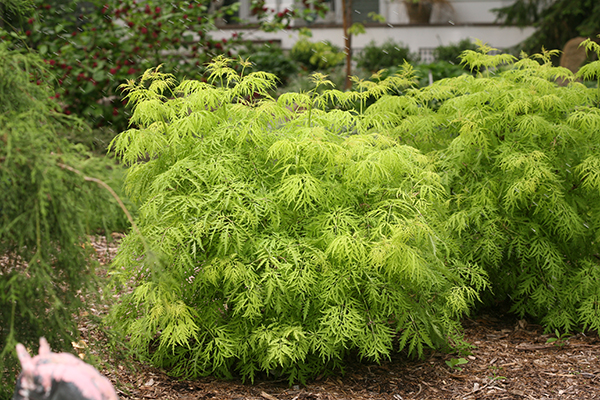 |
| Patrick Pineau with Coppertina ninebark |
It takes the French touch to reinvent a North American standard, or so Minier Nurseries would have us believe. Located in the famed Anjou region of France, Minier has established itself as a leading name in European horticulture after a century and a half of breathing excitement into plants that may have been otherwise overlooked. Consider the
Show Off® forsythia series whose compact varieties bloom from base to tip. Minier's work with Ceanothus hybrids like
Marie Rose™ and
Marie Bleu™ combines the color of California lilac and the hardiness of New Jersey tea for attention grabbing landscape options. Perhaps you have heard of a little plant called 'Josee' lilac. Yup, also from Minier.
Patrick Pineau, head of Research and Development for Minier Nurseries, has worked with us to bring 13 varieties to the Proven Winners flowering shrub collection. It was this ongoing relationship that prompted our invitation for him to join us at
MANTS for the annual garden writers luncheon. Unfortunately, the Polar Vortex had other plans, and Patrick made it as far as Toronto before turning back to France. After recovering from his travels, he sat down to answer a few questions about French gardens today and the plants that make up this new landscape.
How did you become involved in the horticulture industry?
Minier nurseries have been a historical anchor of French horticulture since 1856, but its main development was after the second world war at the impulse of Robert Minier, who has developed international connections with other nurseries, especially with US nurseries like
Iseli for conifers.
In that same time, Minier started breeding activity, especially in
Hibiscus syriacus and
Syringa vulgaris. Now, in 40 years, Minier has launched more than 40 selections to the market, and some of them are now mainstays for all growers in Europe.
In your opinion, what does the quintessential French landscape look like?
Of course, everybody knows the classical French gardens: the old castles with Buxus, Carpinus and Taxus pruned, but now the French landscape is more about the use and layout of little urban spaces with compact shrubs, grasses, climbing plants, and little trees. Using color is also important; French gardens are not green and uniform like in the past, but evolve across the seasons while keeping a certain structure and using perspective.
How are the plants bred by Minier changing or continuing this French tradition?
In the past 20 years, plant consumption habits have changed, linked to decreasing available space. It's the reason why we focus on compact plants and little trees. Minier carries on its work on
Syringa vulgaris genus (a historical genus by well-known French breeder Lemoine at the beginning of last century) and
Hibiscus syriacus, but, of course, we are looking for compact habits, sterility and diseases resistance, three of most important things demanded by new gardeners.
What trends are you seeing in new woody ornamentals? What traits are you looking for in a plant?
Disease resistance and drought resistance seem to be important, and we focus also on maintenance in the garden. Also, we have to think about the main needs of the market in 10 or 15 years, especially for trees.
Which Minier plants in the Proven Winners line have the most unique or surprising traits?
Of course, as a breeder, Minier considers all his plants unique, but we are also growers, and we focus also on improved performance in production for our partners. For example, Forsythia
Show Off® Starlet is a neat, sanitary improvement in container production in comparison to the recent compact varieties on the market. It's the same for Ceanothus
Marie Rose®, which needs less pruning for the growers. And, what is good for growers is also good for the gardens.
What is your favorite Proven Winners ColorChoice shrub?
One of our favorites is Physocarpus
Coppertina® with its new copper colored leaves in spring. It is easy to grow and without problems in garden - well in phase with the new trends in the garden.
Thank you for your time, Patrick!
For a detailed look at the 13 Minier varieties in the Proven Winners ColorChoice collection, please visit our slideshow:
The French Connection: Proven Winners ColorChoice Flowering Shrubs from Minier Nursery.
*Interview was edited for clarity.





























